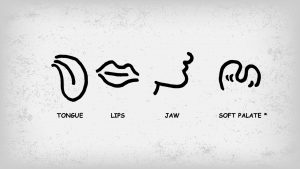Any moveable mouth or throat part could be a speech articulator. Whenever you move a mouth part like your tongue and vocalize at the same time, you have articulated something: it may or may not be real speech.
Say: “lalalalalala…” in front of the mirror and notice your tongue flapping up and down in your mouth on “l”.
You have just articulated some speech sounds. (Since there was no emotional intent or meaning in the utterance, we can’t assume you communicated anything).
Some speech sounds are articulated without vocalizing at all; instead they disturb airflow to make a “pop” or a “hiss”. Try saying “p”; “t”; “ssssss”; “sh”; “ch” while you watch your articulators in a mirror.
The articulators are responsible for most of the resonance space shaping, as we demonstrated in the last section.
In a way, the moveable mouth parts serve to “decorate” the flow of vocalization from the vocal tract and turn it into recognizable speech. This, of course is a very important function for human beings.

